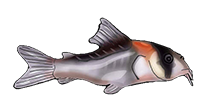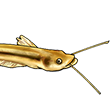A question to all you scientific types
- grokefish
- Posts: 1554
- Joined: 13 Apr 2006, 19:28
- My images: 3
- My aquaria list: 1 (i:0)
- Spotted: 2
- Location 1: The Vandart Aquarium South Wales
- Interests: Life the universe and everything
A question to all you scientific types
Parancistrus aurantiacus is described as the type locality being the Rio Ucayali in Peru.
The distribution being this river and also the Tocatins and Xingu rivers.
This distribution, to my ignorant brain, seems very strange as these rivers are a large distance from each other and are not really linked.
Unless these fish swam all the way from the Xingu/Tocatins up the amazon to the Ucayali or the other way without stopping on the way (oviously over thousands of years) it seems to me that these surely must be a different fish, a parrallel evolution or a mistake.
Having never been to any of these rivers and much information on these rivers having evaded me, are these rivers similar (water chemistry and other more obvious characteristics like flow turbidity, food sources,substrates,plant density, local shopping, handy parking...) that would make them ideal conditions for this fish to thrive?
I asume (maybe incorrectly) that the rio Ucayali is much colder than the Xingu and Tocatins.
This is a puzzle that I am uncapable of figureing out (as it is not made of metal and I can't hit it with a hammer) and it really does bug me, sad though that may seem.
Please help, the voices are stopping me from sleeping.
Matt
The distribution being this river and also the Tocatins and Xingu rivers.
This distribution, to my ignorant brain, seems very strange as these rivers are a large distance from each other and are not really linked.
Unless these fish swam all the way from the Xingu/Tocatins up the amazon to the Ucayali or the other way without stopping on the way (oviously over thousands of years) it seems to me that these surely must be a different fish, a parrallel evolution or a mistake.
Having never been to any of these rivers and much information on these rivers having evaded me, are these rivers similar (water chemistry and other more obvious characteristics like flow turbidity, food sources,substrates,plant density, local shopping, handy parking...) that would make them ideal conditions for this fish to thrive?
I asume (maybe incorrectly) that the rio Ucayali is much colder than the Xingu and Tocatins.
This is a puzzle that I am uncapable of figureing out (as it is not made of metal and I can't hit it with a hammer) and it really does bug me, sad though that may seem.
Please help, the voices are stopping me from sleeping.
Matt
One more bucket of water and the farce is complete.
- racoll
- Posts: 5258
- Joined: 26 Jan 2004, 12:18
- My articles: 6
- My images: 182
- My catfish: 2
- My cats species list: 2 (i:2, k:0)
- My aquaria list: 1 (i:0)
- Spotted: 238
- Location 1: London
- Location 2: UK
I agree it does seem odd.
The possibility for a mistake is definitely there. There have been many mix-ups with descriptions and traded species, especially as this one was described in 1855.
As far as I know the Ucayali is a white water river that carries significant amounts of sediment down from the Andes. The water is probably cooler in the upper reaches, but perhaps gets warmer as if enters the Amazon lowlands.
The Tocatins and Xingu as you know are warm, clear, soft and acidic in nature, and flow over extensive rock formations in the Brazilian Highlands.
The Ucayali very long way indeed from the Tocatins and Xingu, and it does seem strange that the fish has not been recorded in intermediate rivers.
There is quite a large piece on this in Wels Atlas II, but until either they print an English version or my German dramatically improves, we may be none the wiser.
Perhaps a German speaker could fill us in?
.
The possibility for a mistake is definitely there. There have been many mix-ups with descriptions and traded species, especially as this one was described in 1855.
As far as I know the Ucayali is a white water river that carries significant amounts of sediment down from the Andes. The water is probably cooler in the upper reaches, but perhaps gets warmer as if enters the Amazon lowlands.
The Tocatins and Xingu as you know are warm, clear, soft and acidic in nature, and flow over extensive rock formations in the Brazilian Highlands.
The Ucayali very long way indeed from the Tocatins and Xingu, and it does seem strange that the fish has not been recorded in intermediate rivers.
There is quite a large piece on this in Wels Atlas II, but until either they print an English version or my German dramatically improves, we may be none the wiser.
Perhaps a German speaker could fill us in?
.
-
tomkom2
- Posts: 5
- Joined: 28 Oct 2005, 17:19
- My images: 3
- Spotted: 1
- Location 1: Germany-Bavaria
- Interests: Biodiversity
- Contact:
Hello,
to make your sleep more comfortable I try to outline what I found in WA-II about this phenomenom.
Basically, the authors also doubt that all specimens labeled as P.aurantiacus belong to the same species, claming that those from Rio Xingu are confused with L332. They are also irritated about the supposed huge, discontinuous area of occurence of a single species and the quite limited geographical occurence of other members of the genus.
That´s the quintessence of the WA-II article concerning your question and I hope it helps to bring your sleep back...
christmas greetings from Bavaria,
Matthias
to make your sleep more comfortable I try to outline what I found in WA-II about this phenomenom.
Basically, the authors also doubt that all specimens labeled as P.aurantiacus belong to the same species, claming that those from Rio Xingu are confused with L332. They are also irritated about the supposed huge, discontinuous area of occurence of a single species and the quite limited geographical occurence of other members of the genus.
That´s the quintessence of the WA-II article concerning your question and I hope it helps to bring your sleep back...
christmas greetings from Bavaria,
Matthias
- Jools
- Expert
- Posts: 16268
- Joined: 30 Dec 2002, 15:25
- My articles: 198
- My images: 941
- My catfish: 237
- My cats species list: 87 (i:235, k:1)
- My BLogs: 7 (i:10, p:167)
- My Wishlist: 23
- Spotted: 450
- Location 1: Middle Earth,
- Location 2: Scotland
- Interests: All things aquatic, Sci-Fi, photography and travel. Oh, and beer.
- Contact:
I seem to remember there was a Brazilian junior synonym. P. nigricans or something like that. This is where the current position was arrived at over time I'd suggest.
What's interesting to note is one name makes reference to a golden colour and one name makes colour of a black colour. I'm guessing here, but when it was discovered that they change colour, synonymy probably followed.
Jools
What's interesting to note is one name makes reference to a golden colour and one name makes colour of a black colour. I'm guessing here, but when it was discovered that they change colour, synonymy probably followed.
Jools
Owner, AquaticRepublic.com, PlanetCatfish.com & ZebraPleco.com. Please consider donating towards this site's running costs.





